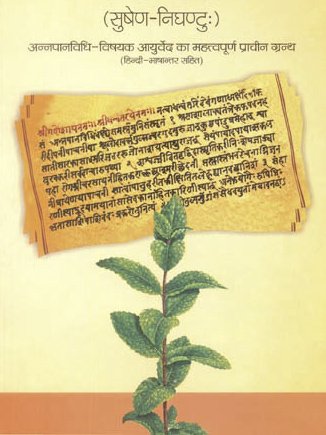Indravaruni, Imdravaruni, Indra-varuni, Indravāruṇī, Indravārūṇi: 14 definitions
Introduction:
Indravaruni means something in Hinduism, Sanskrit, Marathi, biology. If you want to know the exact meaning, history, etymology or English translation of this term then check out the descriptions on this page. Add your comment or reference to a book if you want to contribute to this summary article.
In Hinduism
Ayurveda (science of life)
Rasashastra (Alchemy and Herbo-Mineral preparations)
Source: Wisdom Library: Rasa-śāstraIndravārūṇi (इन्द्रवारूणि):—One of the sixty-seven Mahauṣadhi, as per Rasaśāstra texts (rasa literature). These drugs are useful for processing mercury (rasa), such as the alchemical processes known as sūta-bandhana and māraṇa.
Nighantu (Synonyms and Characteristics of Drugs and technical terms)
Source: WorldCat: Rāj nighaṇṭuIndravāruṇī (इन्द्रवारुणी) is the Sanskrit name for a medicinal plant identified with Citrullus colocynthis (colocynth, bitter apple or desert gourd) from the Cucurbitaceae or “gourd family” of flowering plants, according to verse 3.70-72 of the 13th-century Raj Nighantu or Rājanighaṇṭu. Indravāruṇī is commonly known in Hindi and Marathi as Indrāyan; in Bengali as Mākal; in Gujarati as Indra-vana; in Telugu as Etipuchchhā; and in Tamil as Peyttummattī.
Indravāruṇī is mentioned as having twenty-nine synonyms: Aindrī, Aruṇā, Mṛgādanī, Gavādanī, Sūryā, Viṣaghnī, Guṇakarṇikā, Amrā, Mātā, Suvarṇā, Suphalā, Tārakā, Vṛṣabhākṣī, Gavākṣī, Pītapuṣpī, Indravallarī, Hemapuṣpī, Kṣudraphalā, Vāruṇī, Bālakapriyā, Raktervāru, Viṣalatā, Śakravallī, Viṣāpahā, Amṛtā and Viṣavallī.
Properties and characteristics: “Indravāruṇī is bitter (tikta) and pungent (kaṭu) in rasa an cold in potency (śīta). It is a purgative and useful in abdominal distentions and other associated ailments specially pittaja ailments of abdomen and gulma (false abdominal lumps due to wind), diseases due to kapha-doṣā, worms, fevers and leprosy and allied skin disorders”.
Kalpa (Formulas, Drug prescriptions and other Medicinal preparations)
Source: Shodhganga: Edition translation and critical study of yogasarasamgrahaIndravāruṇī (इन्द्रवारुणी) refers to the medicinal plant known as “Cucumis trigonus Roxb.” and is dealt with in the 15th-century Yogasārasaṅgraha (Yogasara-saṅgraha) by Vāsudeva: an unpublished Keralite work representing an Ayurvedic compendium of medicinal recipes. The Yogasārasaṃgraha [mentioning indravāruṇī] deals with entire recipes in the route of administration, and thus deals with the knowledge of pharmacy (bhaiṣajya-kalpanā) which is a branch of pharmacology (dravyaguṇa).
Toxicology (Study and Treatment of poison)
Source: Shodhganga: Kasyapa Samhita—Text on Visha ChikitsaIndravāruṇi (इन्द्रवारुणि) (also Sahasrakṛt) refers to an herbal ingredient which is included in a (snake) poison antidote recipe, according to the Kāśyapa Saṃhitā: an ancient Sanskrit text from the Pāñcarātra tradition dealing with both Tantra and Viṣacikitsā—an important topic from Āyurveda which deals with the study of Toxicology (Viṣavidyā or Sarpavidyā).—Kāśyapa prescribes various antidotes to quell the poison by administering them through nasal drugs, collyrium, ointment, herbal drinks and diet. According to Kāśyapasaṃhitā (verse VIII.10)—“A combination of Śirīṣa juice, Indra Vāruṇi referred also as Sahasrakṛt, and white pepper serves as a thunderbolt to poison and can be used as either a collyrium or ointment or drink”.
Unclassified Ayurveda definitions
Source: Namah Journal: An overview of certain Āyurvedic herbs in the management of viral hepatitisIndravaruṇi (इन्द्रवरुणि) refers to the medicinal plant known as Citrullus colocynthis, Schard., and is employed in the treatment of Kāmala.—Among the single and compound preparations described in Āyurveda for the treatment of kāmala, some of the drugs have been found to be effective. A scientific study of the drugs [viz., Indravaruṇi] was carried out and significant response observed.

Āyurveda (आयुर्वेद, ayurveda) is a branch of Indian science dealing with medicine, herbalism, taxology, anatomy, surgery, alchemy and related topics. Traditional practice of Āyurveda in ancient India dates back to at least the first millenium BC. Literature is commonly written in Sanskrit using various poetic metres.
Purana and Itihasa (epic history)
Source: archive.org: Shiva Purana - English TranslationIndravāruṇī (इन्द्रवारुणी) refers to “bitter beer (mixed with sugar)”, according to the Śivapurāṇa 2.3.24 (“Śiva consents to marry Pārvatī”).—Accordingly, as Śiva said to Viṣṇu: “[...] O Indra, a man attains downfall even by conversing with a sensuous person. Great preceptors say that worldly enjoyment is a bitter beer mixed with sugar [i.e., indravāruṇī—sitāliteṃdravāruṇīm]. Although I know and realise all these, although I have specific wisdom yet I shall accede to your request and make it fruitful. I am definitely subservient to my devotees. Hence I may do everything. I am known all over the three worlds as one who performs ill fitting things. [...]”.

The Purana (पुराण, purāṇas) refers to Sanskrit literature preserving ancient India’s vast cultural history, including historical legends, religious ceremonies, various arts and sciences. The eighteen mahapuranas total over 400,000 shlokas (metrical couplets) and date to at least several centuries BCE.
Biology (plants and animals)
Source: Google Books: CRC World Dictionary (Regional names)Indravaruni in India is the name of a plant defined with Citrullus colocynthis in various botanical sources. This page contains potential references in Ayurveda, modern medicine, and other folk traditions or local practices It has the synonym Cucumis colocynthis L. (among others).
Example references for further research on medicinal uses or toxicity (see latin names for full list):
· Species Plantarum
· Index Seminum [Goettingen] (1833)
· Garcia Orta, Sér. Bot. (1976)
· The Gardeners Dictionary (1754)
· Linnaea (1838)
If you are looking for specific details regarding Indravaruni, for example extract dosage, health benefits, pregnancy safety, diet and recipes, chemical composition, side effects, have a look at these references.

This sections includes definitions from the five kingdoms of living things: Animals, Plants, Fungi, Protists and Monera. It will include both the official binomial nomenclature (scientific names usually in Latin) as well as regional spellings and variants.
Languages of India and abroad
Marathi-English dictionary
Source: DDSA: The Molesworth Marathi and English Dictionaryindravāruṇī (इंद्रवारुणी).—f S Bitter gourd-plant, Cucumis colocynthis.
Marathi is an Indo-European language having over 70 million native speakers people in (predominantly) Maharashtra India. Marathi, like many other Indo-Aryan languages, evolved from early forms of Prakrit, which itself is a subset of Sanskrit, one of the most ancient languages of the world.
Sanskrit dictionary
Source: DDSA: The practical Sanskrit-English dictionaryIndravāruṇī (इन्द्रवारुणी).—Colocynth, a wild bitter gourd cucumis colocynthis. (Mar. moṭhī kaṃvaḍaḷa) किमिन्द्रवारुणी राम सितया कटुकीयते (kimindravāruṇī rāma sitayā kaṭukīyate) Laghu Yogavāsiṣṭha-sāra X. सौवर्चलं हरिद्रा च पिप्पली चेन्द्रवारुणिः । मूत्र- कृच्छ्रे प्रशंसन्ति पिण्डोऽयं वाजिनां हितः ॥ शालिहोत्र (sauvarcalaṃ haridrā ca pippalī cendravāruṇiḥ | mūtra- kṛcchre praśaṃsanti piṇḍo'yaṃ vājināṃ hitaḥ || śālihotra) of भोज (bhoja) 33.
Indravāruṇī is a Sanskrit compound consisting of the terms indra and vāruṇī (वारुणी). See also (synonyms): indravāruṇikā.
Source: Cologne Digital Sanskrit Dictionaries: Shabda-Sagara Sanskrit-English DictionaryIndravāruṇī (इन्द्रवारुणी).—f. (-ṇī) See the preceding. E. indra and varuṇa the two deities so called, affixes aṇ and ṅīp; the favourite plant of Indra and Varuna.
Source: Cologne Digital Sanskrit Dictionaries: Monier-Williams Sanskrit-English Dictionary1) Indravāruṇī (इन्द्रवारुणी):—[=indra-vāruṇī] [from indra] f. Colocynth, a wild bitter gourd, Cucumis Colocynthis
2) [v.s. ...] the favourite plant of Indra and Varuṇa [commentator or commentary] on [Kātyāyana-śrauta-sūtra; cf. Lexicographers, esp. such as amarasiṃha, halāyudha, hemacandra, etc.]
Source: Cologne Digital Sanskrit Dictionaries: Yates Sanskrit-English DictionaryIndravāruṇī (इन्द्रवारुणी):—[indra-vāruṇī] (ṇī) 3. f. Idem.
[Sanskrit to German]
Sanskrit, also spelled संस्कृतम् (saṃskṛtam), is an ancient language of India commonly seen as the grandmother of the Indo-European language family (even English!). Closely allied with Prakrit and Pali, Sanskrit is more exhaustive in both grammar and terms and has the most extensive collection of literature in the world, greatly surpassing its sister-languages Greek and Latin.
Kannada-English dictionary
Source: Alar: Kannada-English corpusIṃdravāruṇi (ಇಂದ್ರವಾರುಣಿ):—
1) [noun] an Asian perennial vine (Citrullus colocynthis) of the gourd family (Cucurbitaceae).
2) [noun] its small, dried fruits, used in making a strong cathartic; colocynth.
--- OR ---
Iṃdrāvaruṇi (ಇಂದ್ರಾವರುಣಿ):—[noun] = ಇಂದ್ರವಾರುಣಿ [imdravaruni].
Kannada is a Dravidian language (as opposed to the Indo-European language family) mainly spoken in the southwestern region of India.
See also (Relevant definitions)
Partial matches: Varuni, Indra.
Starts with: Indravaruni mool, Indravarunika.
Query error!
Full-text (+48): Indravallari, Vishapaha, Shakravalli, Indravaruni mool, Mrigadana, Indravarunika, Vishalata, Intiravaruni, Indravana, Kshudraphala, Raktairvaru, Sthanukarni, Kentivaruni, Gajacirbhata, Kantivaruni, Indravaruna, Taraka, Raktervaru, Indracirbhiti, Aruna.
Relevant text
Search found 16 books and stories containing Indravaruni, Imdravaruni, Iṃdravāruṇi, Iṃdrāvaruṇi, Indra-vāruṇī, Indra-varuni, Indravāruṇī, Indravārūṇi, Indravāruṇi, Indrāvaruṇi; (plurals include: Indravarunis, Imdravarunis, Iṃdravāruṇis, Iṃdrāvaruṇis, vāruṇīs, varunis, Indravāruṇīs, Indravārūṇis, Indravāruṇis, Indrāvaruṇis). You can also click to the full overview containing English textual excerpts. Below are direct links for the most relevant articles:
Garuda Purana (by Manmatha Nath Dutt)
Chapter CCXIII - Other Medicinal Recipes (continued) < [Dhanvantari Samhita]
Chapter CCVII - Various other medicinal Recipes (continued) < [Dhanvantari Samhita]
Chapter CXCVII - Preparations of medicinal oils and Ghritas < [Dhanvantari Samhita]
Rasa Jala Nidhi, vol 3: Metals, Gems and other substances (by Bhudeb Mookerjee)
Part 5 - Incineration of Yellow Diamonds < [Chapter XIII - Gems (1): Vajra or Hiraka (diamond)]
Part 4 - Incineration of Vaikranta < [Chapter XX - Gems (8): Vaikranta (garnet)]
Part 3 - Extraction of oil from seeds of Ankota and Bakuchi < [Chapter XXXII - Extraction of oil from seeds]
Amarakoshodghatana of Kshirasvamin (study) (by A. Yamuna Devi)
Flora (9): Common weed < [Chapter 5 - Aspects of Nature]
Atharvaveda and Charaka Samhita (by Laxmi Maji)
4a. Kuṣṭha-roga (leprosy) in the Atharvaveda < [Chapter 5 - Diseases and Remedies in Atharvaveda and Caraka-Saṃhitā]
Treatment of Skin diseases (Carmaroga) and Leprosy (Kuṣṭha) < [Chapter 3 - Diseases and Remedial measures (described in Atharvaveda)]
World Journal of Pharmaceutical Research
Pharmacognostical and pharmaceutical evaluation of madhumehari vati < [2018: Volume 7, March issue 5]
Vishaladi Lepa for managing cyclical mastalgia: A conceptual study < [2021: Volume 10, September issue 11]
Vishamusti Vati: A Comprehensive Analysis of Its Pharmacological Properties < [2018: Volume 7, October issue 17]
Bhesajjakkhandhaka (Chapter on Medicine) (by Hin-tak Sik)
Medicines (m): Unclassified Substances < [Chapter 4 - Medicinal Substances in the Chapter on Medicine]
Related products
(+1 more products available)





